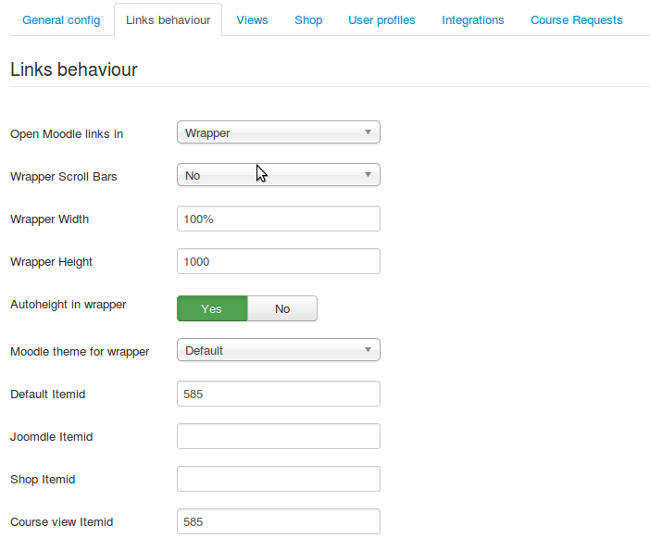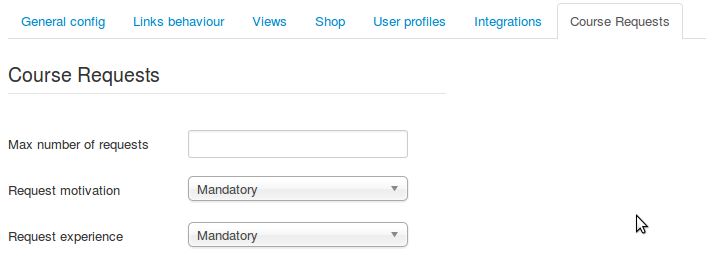Installing Joomdle in Joomla
|
English |
This document applies to Joomdle Release 2.0.0
Contents
Preparing Joomla! for Joomdle
Before you install Joomdle ensure that Joomla is installed and running correctly.
- Complete any Prerequisites required for Joomdle
.
Installing Joomdle for Joomla!
The Joomdle for Joomla! extension consists of a Component and some modules and plugins. Additionally, you can download many more Joomdle packages from Joomdle website. To install Joomdle for Joomla!, use Joomla!'s Extension Manager and select the Joomdle package called "joomdle-joomla-package.zip". The component, plugins and modules will all be installed as one package simplifying the installation for you.
Note: It also enables all the plugins and creates the modules although they are not published.
To use the rest of plugins and modules, not included in the main package, you will need to install them separately.
.
Configuring Joomdle for Joomla!
Configuring Joomdle for Joomla! is done through the Configuration screen which can be found by choosing Configuration option in the Joomdle Component menu, or through the Joomdle dashboard. There are several sections that you can configure, however, only some items are mandatory to start.
General config
In this section you can configure Joomdle basic settings.
- Moodle URL
- Enter the full URL and path of your Moodle installation - this is likely to be http: //www.mydomain.com/moodle assuming you have installed Moodle in a directory called moodle off the Joomla! root. Remember to add http:// in front of your URL.
- Moodle auth token
- Enter the auth token you obtained when you installed Joomdle on Joomla.
- Connection method
- Available options are: file_get_contents and cURL. Select the one available on your server.
- Joomla auth token
- This will be auto-generated when you save configuration. You will need to enter this string in Joomdle config in Moodle.
- Use redirectless SSO
- This option only works with cURL and both Moodle and Joomla on the same domain. It makes Joomdle do Single Sign On without redirecting the user back and forward. This is mostly useful for shops, so the purchase process is not broken on user logging.
- Use redirectless logout
- This option only works when both Moodle and Joomla are on the same domain. It makes Joomdle do Single log out without redirecting the user back and forward.
- Moodle Cookie Path
- This option is only needed for redirect-less SSO. You will need to copy here the value that you can find in the Cookie path setting in Moodle->Site Administration->Server->Session Handling.
- Auto create Moodle users
- Set this to "Yes" if you want Joomdle to automatically create new users in Moodle when they register in Joomla!.
- Auto delete Moodle users.
- Set this to "Yes" if you want Joomdle to automatically delete users in Moodle when they are deleted in Joomla!.
Links behaviour
Here you can find links and wrapper configuration.
- Open Moodle links in
- The parameter tells Joomdle how to respond when you click on any of the Joomdle links.
- Open in the same window
- Open in new window
- Open in wrapper
- The parameter tells Joomdle how to respond when you click on any of the Joomdle links.
To use this, you may need to enable an option in Moodle configuration:
Site admin->Security->HTTP Security: Allow frame embedding
- Wrapper scroll bars
- Wrapper width
- Wrapper height
- Autoheight in wrapper
NOTE: this only works when both Joomla and Moodle are on the same domain, unless next option is enabled.
- Cross-domain auto-height
- This uses a 3rd party library and requires additional configuration. See Crossdomain Wrapper Autoheight
- Moodle theme for wrapper
- You can select a specific Moodle theme to be used with Joomdle wrapper. Set Default to use default Moodle theme.
You will need to enable "Allow theme change by URL" in Moodle configuration, in Site Administration->Appearance->Themes->Theme settings
- Default Itemid
- This lets you specify a default itemid to be associated to all calls to the Moodle wrapper
- Joomdle Itemid
- This lets you specify a default itemid to be associated to all calls to the Joomdle component from Joomdle modules
- Shop Itemid
- This lets you specify a default itemid to be associated to all calls to the shop component from Joomdle
- Course Itemid
- Item ID for the course view, used for configuring course-related modules
Views
Action buttons
- Show button for free courses
- Button to show for free courses, in detail and lists views
- Show button for paid courses
- Button to show for paid courses
- Go to course button
- Where to link to with course button
Topics view
- Show headings
Course category view
- Show category info
- Show action buttons
Course view
- Show headings
- Show topics summary
- Use page view
- Use Kunena forums
Back links
- Show back links
Detail view
- Show category
- Show course summary
- Show language
- Show start date
- Show enrol dates
- Show enrol period
- Show number of topics
- Show cost
- Show Contents link
- Show Topics link
- Show Grading system link
- Show Teachers link
Courses ABC view
- Show action buttons
Shop
Here you can configure Joomdle shop integration, to sell Moodle courses with a Joomla e-commerce extension.
- Shop integration
- Select e-commerce component to sell courses. You can add more components by downloading specific integration plugins from Joomdle site.
- Category ID
- The Product Category ID that you wish Moodle Courses to appear under.
- Buy courses for children
- Enable this option if you are using the Features for parents. If not, set it to No.
- Subject of email
- Enter the subject of the email sent when successfully purchasing a Moodle course.
- Body of email
- Enter the body of the email sent when successfully purchasing a Moodle course.
- Send bundle emails
- Send course welcome emails for all courses in bundles.
User profiles
This section lets you configure everything related to user profiles and groups.
- Additional Data source
- Select other component to provide additional user information to Joomdle, You can add more components by downloading specific integration plugins from Joomdle site.
If you select Joomla 1.6 user profiles, and use a non-standard profile plugin, you can configure it in the next two fields. Otherwise, leave them blank.
- 1.6+ User Profile Form Path
- J1.6+ Profile plugin
More info on this feature can be found here: Field Data Mapping
- Use Profile Types
- Select a component to manage profile types
If you want to use the Usergroups feature, here you can configure the parent groups:
- Teachers group
- Students group
- Activities
- Select component for wall activities
- User points integration
- Select a component to manage user points
- Social extension groups
- Select a component to manage social groups.
- Category for course groups
- Group category for course groups
Integrations
In this section you can configure additional integrations.
- Mailing lists integration
- Select component for mailing lists integration
- Use PDF integration
- Show PDF links in some grade views
- Main course forums category
- Kunena category for course forums
Course requests
In this section you can configure course requests settings.
- Max number of requests
- Max number of requests (pending and accepted) a user can have.
When using course requests, you can also configure Joomdle to ask for additional info:
- Request motivation
- No, Optional, Mandatory
- Request experience
- No, Optional, Mandatory
System Health Check
Once you have installed and configure Joomdle, please visit the System Health Check tab to ensure all items have been configured correctly.
Refer to System health check for details with possible issues and associated resolutions.
.
Recommended plugins
Once you have Joomdle working fine, you should install Joomdle User Check plugin, or Joomdle Jomsocial User check plugin if you are using Jomsocial.
This plugin will prevent users from using caps and other chars not permitted in Moodle when they register in Joomla. This will avoid user sync errors caused by username mismatch.
.






